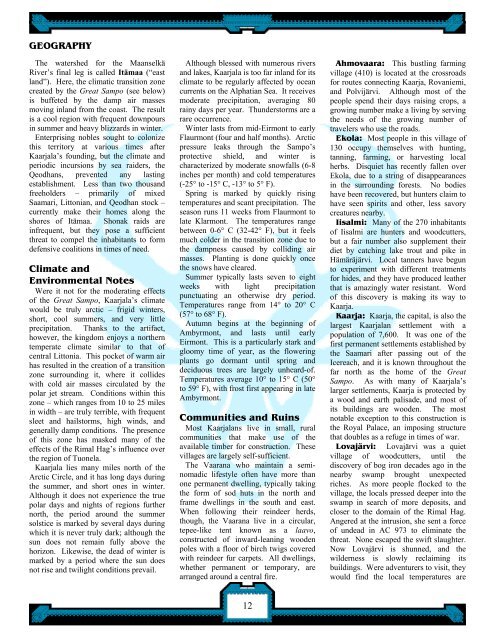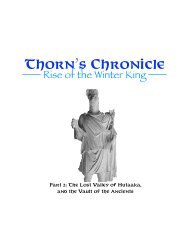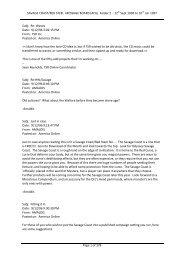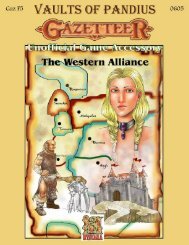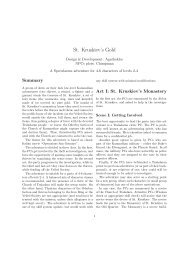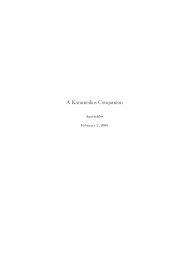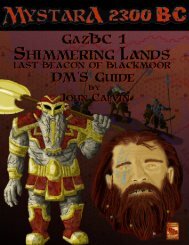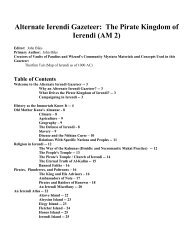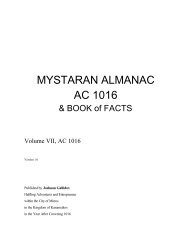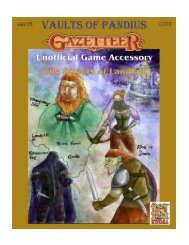Gaz F10 The Kingdom of Kaarjala - Vaults of Pandius
Gaz F10 The Kingdom of Kaarjala - Vaults of Pandius
Gaz F10 The Kingdom of Kaarjala - Vaults of Pandius
Create successful ePaper yourself
Turn your PDF publications into a flip-book with our unique Google optimized e-Paper software.
GEOGRAPHY<strong>The</strong> watershed for the MaanselkäRiver’s final leg is called Itämaa (“eastland”). Here, the climatic transition zonecreated by the Great Sampo (see below)is buffeted by the damp air massesmoving inland from the coast. <strong>The</strong> resultis a cool region with frequent downpoursin summer and heavy blizzards in winter.Enterprising nobles sought to colonizethis territory at various times after<strong>Kaarjala</strong>’s founding, but the climate andperiodic incursions by sea raiders, theQeodhans, prevented any lastingestablishment. Less than two thousandfreeholders – primarily <strong>of</strong> mixedSaamari, Littonian, and Qeodhan stock –currently make their homes along theshores <strong>of</strong> Itämaa. Shonak raids areinfrequent, but they pose a sufficientthreat to compel the inhabitants to formdefensive coalitions in times <strong>of</strong> need.Climate andEnvironmental NotesWere it not for the moderating effects<strong>of</strong> the Great Sampo, <strong>Kaarjala</strong>’s climatewould be truly arctic – frigid winters,short, cool summers, and very littleprecipitation. Thanks to the artifact,however, the kingdom enjoys a northerntemperate climate similar to that <strong>of</strong>central Littonia. This pocket <strong>of</strong> warm airhas resulted in the creation <strong>of</strong> a transitionzone surrounding it, where it collideswith cold air masses circulated by thepolar jet stream. Conditions within thiszone – which ranges from 10 to 25 milesin width – are truly terrible, with frequentsleet and hailstorms, high winds, andgenerally damp conditions. <strong>The</strong> presence<strong>of</strong> this zone has masked many <strong>of</strong> theeffects <strong>of</strong> the Rimal Hag’s influence overthe region <strong>of</strong> Tuonela.<strong>Kaarjala</strong> lies many miles north <strong>of</strong> theArctic Circle, and it has long days duringthe summer, and short ones in winter.Although it does not experience the truepolar days and nights <strong>of</strong> regions furthernorth, the period around the summersolstice is marked by several days duringwhich it is never truly dark; although thesun does not remain fully above thehorizon. Likewise, the dead <strong>of</strong> winter ismarked by a period where the sun doesnot rise and twilight conditions prevail.Although blessed with numerous riversand lakes, <strong>Kaarjala</strong> is too far inland for itsclimate to be regularly affected by oceancurrents on the Alphatian Sea. It receivesmoderate precipitation, averaging 80rainy days per year. Thunderstorms are arare occurrence.Winter lasts from mid-Eirmont to earlyFlaurmont (four and half months). Arcticpressure leaks through the Sampo’sprotective shield, and winter ischaracterized by moderate snowfalls (6-8inches per month) and cold temperatures(-25° to -15° C, -13° to 5° F).Spring is marked by quickly risingtemperatures and scant precipitation. <strong>The</strong>season runs 11 weeks from Flaurmont tolate Klarmont. <strong>The</strong> temperatures rangebetween 0-6° C (32-42° F), but it feelsmuch colder in the transition zone due tothe dampness caused by colliding airmasses. Planting is done quickly oncethe snows have cleared.Summer typically lasts seven to eightweeks with light precipitationpunctuating an otherwise dry period.Temperatures range from 14° to 20° C(57° to 68° F).Autumn begins at the beginning <strong>of</strong>Ambyrmont, and lasts until earlyEirmont. This is a particularly stark andgloomy time <strong>of</strong> year, as the floweringplants go dormant until spring anddeciduous trees are largely unheard-<strong>of</strong>.Temperatures average 10° to 15° C (50°to 59° F), with frost first appearing in lateAmbyrmont.Communities and RuinsMost <strong>Kaarjala</strong>ns live in small, ruralcommunities that make use <strong>of</strong> theavailable timber for construction. <strong>The</strong>sevillages are largely self-sufficient.<strong>The</strong> Vaarana who maintain a seminomadiclifestyle <strong>of</strong>ten have more thanone permanent dwelling, typically takingthe form <strong>of</strong> sod huts in the north andframe dwellings in the south and east.When following their reindeer herds,though, the Vaarana live in a circular,tepee-like tent known as a laavo,constructed <strong>of</strong> inward-leaning woodenpoles with a floor <strong>of</strong> birch twigs coveredwith reindeer fur carpets. All dwellings,whether permanent or temporary, arearranged around a central fire.Ahmovaara: This bustling farmingvillage (410) is located at the crossroadsfor routes connecting Kaarja, Rovaniemi,and Polvijärvi. Although most <strong>of</strong> thepeople spend their days raising crops, agrowing number make a living by servingthe needs <strong>of</strong> the growing number <strong>of</strong>travelers who use the roads.Ekola: Most people in this village <strong>of</strong>130 occupy themselves with hunting,tanning, farming, or harvesting localherbs. Disquiet has recently fallen overEkola, due to a string <strong>of</strong> disappearancesin the surrounding forests. No bodieshave been recovered, but hunters claim tohave seen spirits and other, less savorycreatures nearby.Iisalmi: Many <strong>of</strong> the 270 inhabitants<strong>of</strong> Iisalmi are hunters and woodcutters,but a fair number also supplement theirdiet by catching lake trout and pike inHämäräjärvi. Local tanners have begunto experiment with different treatmentsfor hides, and they have produced leatherthat is amazingly water resistant. Word<strong>of</strong> this discovery is making its way toKaarja.Kaarja: Kaarja, the capital, is also thelargest <strong>Kaarjala</strong>n settlement with apopulation <strong>of</strong> 7,600. It was one <strong>of</strong> thefirst permanent settlements established bythe Saamari after passing out <strong>of</strong> theIcereach, and it is known throughout thefar north as the home <strong>of</strong> the GreatSampo. As with many <strong>of</strong> <strong>Kaarjala</strong>’slarger settlements, Kaarja is protected bya wood and earth palisade, and most <strong>of</strong>its buildings are wooden. <strong>The</strong> mostnotable exception to this construction isthe Royal Palace, an imposing structurethat doubles as a refuge in times <strong>of</strong> war.Lovajärvi: Lovajärvi was a quietvillage <strong>of</strong> woodcutters, until thediscovery <strong>of</strong> bog iron decades ago in thenearby swamp brought unexpectedriches. As more people flocked to thevillage, the locals pressed deeper into theswamp in search <strong>of</strong> more deposits, andcloser to the domain <strong>of</strong> the Rimal Hag.Angered at the intrusion, she sent a force<strong>of</strong> undead in AC 973 to eliminate thethreat. None escaped the swift slaughter.Now Lovajärvi is shunned, and thewilderness is slowly reclaiming itsbuildings. Were adventurers to visit, theywould find the local temperatures are12


